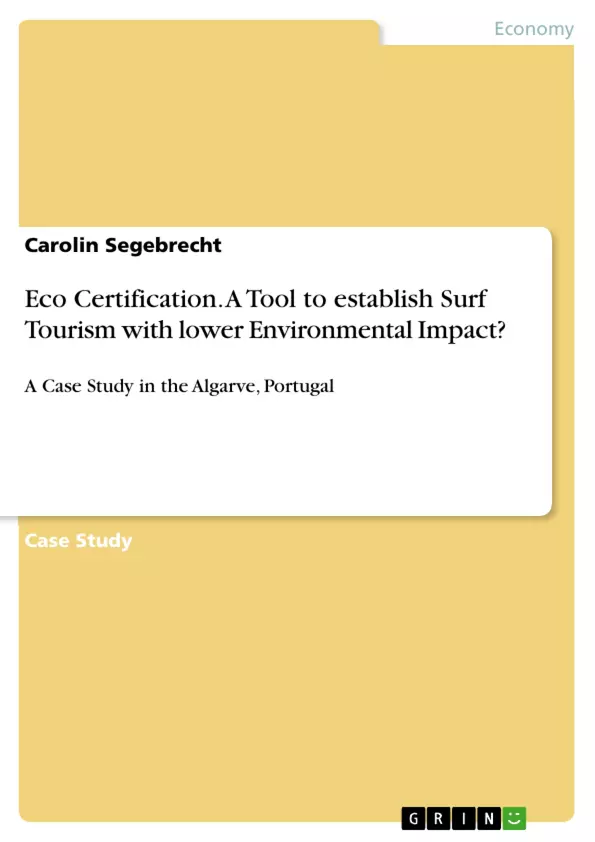With the economic growth of the surf travel industry, its negative impacts on the natural surroundings in which it is taking place are rising. At the same time it contributes to climate change. A growing number of surf schools and surf camps cater for younger surf tourists and offer accommodation and surf safaris especially on the south-western coast of Portugal. Besides the residential or accommodation related impacts like the use of fossil energy, waste water and other consumption related effects, transport from the camp to the surf spot by car is one of the most polluting aspects in the destination. Despite of these impacts, surfing as an activity is less destructive than other tourist action sports or motor-driven water sports. Still, vegetation damage or erosion of hinterland dunes can be caused by surfers searching access to the break as well as damaging reefs while wading through shallow water or while anchoring with a charter boat. Indirectly caused impacts include the manufacturing process of surfboards or wetsuits which is highly polluting. Although board shapers as Kuntiqi Surfboards or enterprises such as Patagonia are trying to use more environment friendly material, the majority still uses foam blanks and petrochemicals. Consequently, the carbon footprint of a traveling surfer should not be underestimated. However, the following quotation shows that surfers are already aware of the negative environmental impacts they cause: “In my experience surfers are usually open minded to the idea that we, as humans, are affecting the climate through our carbon emissions. Due to surfing’s connection with nature, we have a vested interest in ensuring global warming doesn’t get out of hand. For example, rising sea levels will make that low tide reef you love work less often.“ (Lomax 2010, online). For surfing does not work without surfable waves, there is of course a need to focus on sustainability issues also within surf tourism. How aware are European surf tourists of the matter? If so, are they only aware or is there a willingness to actively change their very own behavior or to influence the behavior of surf tourism stakeholders so that negative impacts can be reduced? Could the willingness to pay more for an environmentally friendly operating surf camp appeal to surf camp owners to act in a more eco friendly way?
Inhaltsverzeichnis
- Abstract
- Deutsche Zusammenfassung
- Introduction
- Theoretical Background
- Surfing and Surf Tourism - A Rising Sector
- Surf Tourism in Portugal
- Sustainability in Tourism
- The Role of Certification in Sustainable Tourism
- Methodology
- Research Design
- The Study Area
- Data Collection
- Questionnaires
- Interviews
- Participant Observation
- Data Analysis
- Results
- Demographic Data
- Surf Related Issues
- Environmental Awareness of Surf Tourists
- Attitudes towards Eco Certification in Surf Tourism
- Surf Camp Owners Perspective
- Surf Tourists Perspective
- Discussion
- Awareness of Environmental Issues
- Influence of Awareness on Destination Choice
- Willingness to Pay for Eco Certified Surf Camps
- Conclusions
- Limitations of the Study
- Recommendations
- Bibliography
Zielsetzung und Themenschwerpunkte
This study examines the potential of eco-certification as a tool to promote sustainable surf tourism practices in the Algarve region of Portugal. The study aims to assess the environmental awareness of surf tourists, determine if this awareness influences their choice of destinations and providers, and investigate their willingness to pay more for eco-certified surf camps.
- Environmental impacts of surf tourism
- The role of eco-certification in promoting sustainable tourism
- Environmental awareness among surf tourists
- Factors influencing the choice of surf camps and destinations
- The willingness to pay for eco-friendly surf tourism services
Zusammenfassung der Kapitel
- Introduction: This chapter provides a background on the study's topic, outlining the importance of sustainable surf tourism and the growing demand for eco-friendly travel experiences. It also introduces the research questions and the study's objectives.
- Theoretical Background: This chapter presents a review of relevant literature on surfing, surf tourism, sustainability in tourism, and the role of certification in promoting sustainable practices. It explores the various environmental and social impacts of surf tourism and discusses different approaches to fostering sustainable tourism development.
- Methodology: This chapter details the research design, study area, and data collection methods used for the study. It describes the questionnaires, interviews, and participant observations employed to gather data on surf tourists and surf camp operators' environmental awareness and attitudes towards sustainable surf tourism.
- Results: This chapter presents the findings of the data analysis, covering the demographic profiles of surf tourists, their awareness of environmental issues related to surf tourism, and their preferences regarding eco-certified surf camps. It also examines the perspectives of surf camp owners on eco-certification and sustainability practices.
- Discussion: This chapter analyzes the results and discusses their implications for promoting sustainable surf tourism practices. It explores the factors influencing surf tourists' awareness, destination choices, and willingness to pay for eco-friendly services, and suggests potential strategies for encouraging more sustainable surf tourism development.
Schlüsselwörter
Surf tourism, eco-certification, sustainability, environmental awareness, Algarve, Portugal, surf camp, sustainable tourism management, environmental impacts.
- Quote paper
- Carolin Segebrecht (Author), 2013, Eco Certification. A Tool to establish Surf Tourism with lower Environmental Impact?, Munich, GRIN Verlag, https://www.grin.com/document/229460



